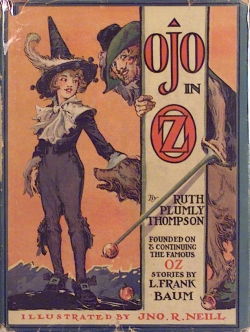Plot
Ojo (from The Patchwork Girl of Oz ) is captured by wanderers who plan to turn him over to a mysterious enemy who has offered to pay a large reward to anyone who captures and delivers Ojo to his stronghold at Moojer Mountain. Ojo befriends the gypsies' captive dancing bear Snufferbux (whose full name is Snuffurious, Buxorious, Blundurious Boroso). The gypsies are in turn captured by Realbad, the leader of a gang of bandits, who carries a secret that is connected to the Munchkin boy and his habitually closemouthed guardian Unc Nunkie. [1] Realbad learns about the reward and resolves to collect it himself by delivering Ojo to Moojer Mountain. Separated from the bandit gang, and hopelessly lost, Ojo and Snufferbux reluctantly agree to travel with Realbad (who is a resourceful survivalist) until they either get to the Emerald City or to Moojer Mountain. While traveling, they face various dangers together and gradually develop a genuine friendship.
Meanwhile, Dorothy, Scraps, and the Cowardly Lion set out to rescue Ojo, but get lost themselves, and visit Dicksey Land and other strange places. Everyone is menaced by a fearsome wizard, and Ojo learns who his parents are.
Reception
The Los Angeles Times said, "What with unicorns and a dancing bear and a frightful gentleman whose face is made up of gearwheels, there are plenty of interesting people in this eventful story." [2] The Minneapolis Star Tribune agreed that the book's adventures "are as fantastic as anything that ever happened in Oz." [3]
In A Brief Guide to Oz, Paul Simpson notes, "Ojo in Oz has attracted some negative attention from recent scholars for the highly stereotypical way in which Thompson describes the Gypsies who feature heavily within the story, and for their eventual fate — others who commit the same crimes are simply transformed into other creatures, but the Gypsies are banished to Southern Europe." [4]
This page is based on this
Wikipedia article Text is available under the
CC BY-SA 4.0 license; additional terms may apply.
Images, videos and audio are available under their respective licenses.
